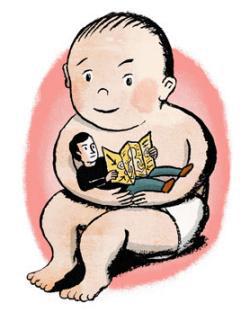Today is the final day of How Babies Work. If this is too much for you to bear, I recommend extended skin-to-skin contact, plus a pacifier dipped in sucrose. It should kill the pain.
The blog was a limited event, timed to my new book Baby Meets World. So this is where I say: If you liked How Babies Work, or even just “liked” it, you’ll love Baby Meets World. If you vaguely tolerated it, you will also love it. If you were enraged by it and left angry comments below, I recommend you buy a copy and destroy it in ceremonial fashion. It will make you feel great. Destroying two will make you feel twice as great.
The book is not a rerun. How Babies Work was almost all material from the cutting room floor: There are glimpses of the book here and there, but just glimpses. (Fine: The Turkish hand-walkers are in the book. Did you think I was going to leave them out?) After I finished the book, I got down on my hands and knees and realized there was enough on the floor to fill up a blog.
Babies are like that: There’s so much going on in infancy that no one can cover all of it. (The lie of the baby manuals, of course, is that they claim to. In reality, they tell you just enough about everything so that you know not nearly enough about any particular thing.) And the babies are only half of it: It’s the parents—the things we have done, the ways we have freaked out—who are the rest of the story. We grown-ups are wondrous creatures too. We’re just as bewildering as the babies, even though we can speak.
Thanks for joining me here. And if you have thoughts about the book, please be in touch. If I don’t answer, it’s only because I can’t hear you over the screaming.
***
Nicholas Day’s book on the science and history of infancy, Baby Meets World, was just published. His website is nicholasday.net. He is @nicksday on Twitter.
